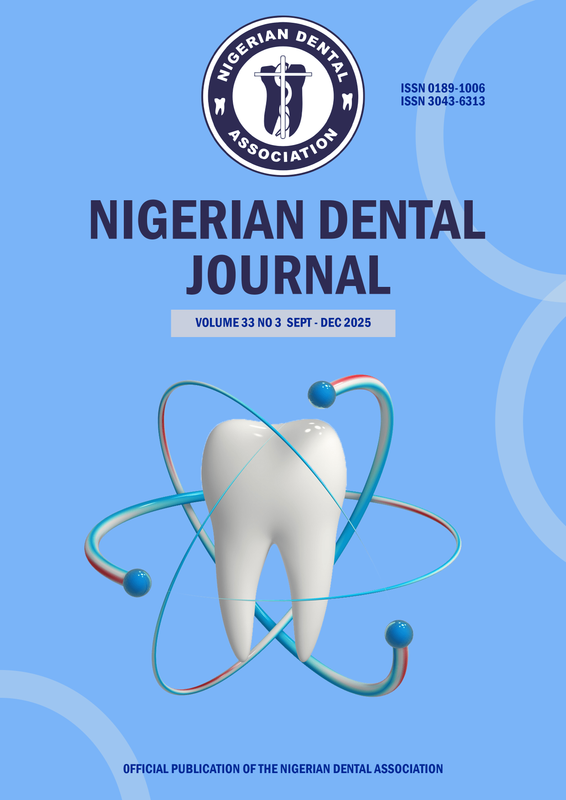Self-Reported Halitosis and Associated Factors Among Medical and Dental Students of a Tertiary Institution in Rivers State, Nigeria
DOI:
https://doi.org/10.61172/ndj.v31i2.253Keywords:
Associated factors, Dental, Medical, Self-reported halitosisAbstract
Objectives: To determine the prevalence of self-reported halitosis and associated factors among medical and dental students of the university of Port Harcourt.
Material and Methods: This was a cross-sectional study, conducted among medical and dental undergraduate students of the University of Port-Harcourt (UPH), Rivers State. Consent was obtained from each participant before being enrolled into the study. Data was collected using a self-administered structured questionnaire. The questionnaire was grouped into four (4) sections; Section A collected demographical information (gender, age, course and level), section B collected information on self-reported halitosis and self-care, section C collected information on oral hygiene practices and section D collected information on associated factors.
Data collected was analysed using the IBM Statistical Package for Social Sciences (SPSS) version 27 (IBM SPSS Armonk, New York) software for Windows. Categorical variables were expressed as frequencies with accompanying percentages. Differences between groups were compared using the Chi-square tests for categorical variables. All statistical significances were assumed at p values <0.05.
Results: A total of 248 medical and dental students were recruited as study participants. The age range was 15-30 years, with a mean age of 22.9 years. The male-to-female ratio is 1.13:1. The prevalence of self-reported halitosis among the study participants was 26%, with the worse experience being in the morning (31.1%). The younger age group reported more halitosis compared to the older age group (p=0.016). More females (34.5%) significantly reported halitosis compared to males (18.2%) [p=0.003]. The occurrence of self-reported halitosis also decreases with an increase in the level of study (p=0.003). Participants that brush thrice a day, and do not use toothbrushes and toothpaste, claim to have halitosis. The majority of the participants who claimed to have dry mouth (76.5%), coated tongue (80.6%) and have a history of smoking (58.3%), reported the presence of halitosis. The majority of participants who take alcohol, claimed not to have halitosis however, this finding is not statistically significant. Seventy-three (29.4%) of the respondents instituted self-care for halitosis in the form of chewing gums (13.71%), minty candy (8.06%), mouth-washes (6.45%), while 1.21% use other options such as compulsive toothbrushing.
Conclusion: Self-reported halitosis was found among 26% of participants. Halitosis occurred more in females and was significantly associated with dry mouth, coated tongue and smoking. 29.4% of the participants instituted self-care to mask their halitosis.
Downloads
References
Rayman S, Almas K. Halitosis among racially diverse populations: An update. Int J Dent Hyg 2008;6:2-7.
Madhushankari GS, Yamunadevi A, Selvamani M, Mohan KP, Basandi PS. Halitosis - An overview: Part-I - Classification, etiology, and pathophysiology of halitosis. J Pharm Bioallied Sci. 2015;7(2):339-343.
Goldberg S, Kozlovsky A, Gordon D, Gelernter I, Sintov A, Rosenberg M. Cadaverine as a putative component of oral malodor. J Dent Res. 1994;73:1168–72.
Scully C, El-Maaytah M, Porter SR, Greenman J. Breath odor: etiopathogenesis, assessment and management. Eur J Oral Sci. 1997;105:287–93
McDowell JD, Kassebaum DK. Diagnosing and treating halitosis. J Am Dent Assoc. 1993;124:55–64
Tessier JF, Kulkarni GV. Bad breath: etiology, diagnosis and treatment. Oral Health. 1991;81:19–22. 24.
Zürcher A, Laine ML, Filippi A. Diagnosis, prevalence, and treatment of halitosis. Curr Oral Health Rep. 2014;1(4):279-385.
Yilmaz AE, Bilici M, Tonbul A, Karabel M, Dogan G, Tas T. Paediatric halitosis and Helicobacter pylori infection. J Coll Physicians Surg Pak. 2012;22:27–30
Oyetola OE, Owotade FJ, Fatusi OA, Olatunji S. Pattern of presentation and outcome of routine dental interventions in patients with halitosis. Niger Postgrad Med J. 2016;23(4):215-220.
Umeizudike KA, Oyetola OE, Ayanbadejo PO, Alade GO, Ameh PO. Prevalence of self-reported halitosis and associated factors among dental patients attending a tertiary hospital in Nigeria. Sahel Med J. 2016;19(3):150-154.
Arowojulo MO, Dosumu EB. Halitosis (Fetor oris) in patients seen at the periodontology clinic of the University College Hospital, Ibadan – A subjective evaluation. Niger Postgrad Med J. 2004;11(3):221-224.
Arinola JE, Olukoju OO. Halitosis amongst students in tertiary institutions in Lagos state. Afr Health Sci. 2012;12(4):473-478.
ADA Council on Scientific Affairs. Oral malodor. J Am Dent Assoc. 2003;134(2):209-214.
Mento C, Lombardo C, Milazzo M, et al. Adolescence, Adulthood and Self-Perceived Halitosis: A Role of Psychological Factors. Medicina. 2021; 57(6):614. https://doi.org/10.3390/medicina57060614
Nazir M, Almas K, Majeed M. The prevalence of halitosis (oral malodor) and associated factors among dental students and interns, Lahore, Pakistan. Eur J Dent. 2017;11(4):480-485.
Lopes MH, Rösing CK, Colussi PR, Muniz FW, Linden MS. Prevalence of self-reported halitosis and associated factors in adolescents from Southern Brazil. Acta Odontol Latinoam. 2016;29(2):93-103.
Bosy A. Oral malodor: Philosophical and practical aspects. J Can Dent Assoc 1997;63:196-201.
Paradowska-Stolarz A. Self-perception of halitosis among students of Wroclaw Medical University. Adv Clin Exp Med. 2007;16(4):543-548.
Kim SY, Sim S, Kim S-G, Park B, Choi HG. Prevalence and associated factors of subjective halitosis in Korean adolescents. PLoS ONE. 2015;10(10):e0140214.
Mubayrik AB, Al Hamdan R, Al Hadlaq EM, et al. Self-perception, knowledge, and awareness of halitosis among female university students. Clin Cosmet Investig Dent. 2017;9:45-52.
Eldarrat A, Alkhabuli J, Malik A. The prevalence of self-reported halitosis and oral hygiene practices among Libyan students and office workers. Libyan J Med. 2008;3(4):170-176.
Van Den Broek AM, Feenstra L, De Baat C. A review of the current literature on management of halitosis. Oral Diseases. 2008;14(1):30-39.
Newman MG, Takei H, Klokkevold PR, Carranza FA, Carranza’s Clinical Periodontology. Elsevier Health Sciences; 2011.
Tin-Oo M, Ying T, Saddki N, Mani S. Self-reported halitosis among medical, dental and health science undergraduate students at the University Sains Malaysia. Acta Stomatologica Croatica. 2013;47(2):137-146.
Kayombo CM, Mumghamba EG. Self-reported halitosis in relation to oral hygiene practices, oral health status, general health problems, and multifactorial characteristics among workers in Ilala and Temeke municipals, Tanzania. Int J Dent. 2017;2017(3):1-10.
Milanesi FC, Kauer B, Wagner TP, Daudt LD, Haas AN. Self-reported halitosis and associated demographic and behavioral factors. Braz Oral Res. 2016;30(1):e71.
De Boever EH, Loesche WJ. Assessing the contribution of anaerobic microflora of the tongue to oral malodor. J Am Dent Assoc. 1995;126(10):1384-1393.
Aylikci BU, Çolak H. Halitosis: From diagnosis to management. J Nat Sc Biol Med. 2013;4(1):14-23.
Al-Rawi AS, Al-Atrooshi BA. Oral halitosis and oral hygiene practices among dental students. J Bagh Coll Dent 2007;19:72-76
Scully C, Greenman J. Halitology (breath odour: aetiopathogenesis and management) Oral Dis. 2012;18(4):333-345
Almas K, Al-Hawish A, Al-Khamis W. Oral hygiene practices, smoking habit, and self-perceived oral malodor among dental students. J Contemp Dent Pract. 2003;4(4):77-90.
Dal Rio AC, Nicola EM, Teixeira AR. Halitosis - an assessment protocol proposal. Brazilian J Otorhinolaryngol. 2007;73(6):835-842.
Bicak DA. A Current Approach to Halitosis and Oral Malodor- A Mini Review. Open Dent J. 2018 Apr 30;12:322-330. doi: 10.2174/1874210601812010322.
Panagakos FS, Volpe AR, Petrone ME, DeVizio W, Davies RM, Proskin HM. Advanced oral antibacterial/anti-inflammatory technology: a comprehensive review of the clinical benefits of a triclosan/copolymer/fluoride dentifrice. J Clin Dent. 2005;16:S1-S19.
Bin MA, Al Hamdan R, Al Hadlaq EM, et al. Self-perception, knowledge, and awareness of halitosis among female university students. Clin Cosmet Investig Dent. 2017;9:45-52.
Downloads
Published
Issue
Section
License
Copyright (c) 2023 Grace Alade

This work is licensed under a Creative Commons Attribution 4.0 International License.
Open Access Statement
- We became fully Open Access since January 2023.
- Our new and archived materials are available free of charge on open basis and under a Creative Commons license as stated below.
Copyright statement
Copyright © 1999 The authors. This work, Nigerian Dental Journal by Nigerian Dental Association is licensed under Creative Commons Attribution 4.0 International License.

